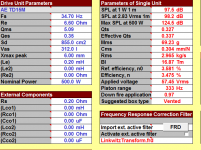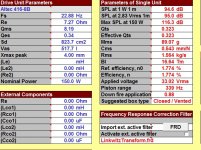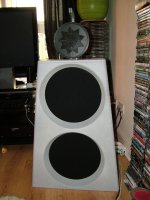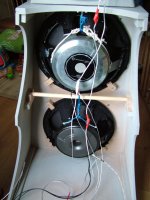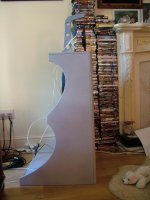Scott L,
IIRC it was the TAD 1201. The problem was the driver would only go down to about 200hz in a modified hypex horn but was good to about 800hz on the high end. This driver had an excellent midrange but did not go low enough for my needs. This was about 10yrs ago and like many other excellent drivers it is no longer in production. I needed to cover 80hz-450hz ( as per Dr. Bruce ) with a single driver which ruled out that TAD driver. I didn't know better back then.
The driver has 55Hz Fs and in suitable horn should comfortably go down to 80hz , even Bruce recommended it for his straight 80-100 1/4 hypex horns with throat adapter. Also it was a driver of choice in monolith horn if I remember correctly.
The LF performance of the midbass channel should be dominated by the horn not by the driver used .Your 15 " based short midbass pipes just add direct radiator boom the same way K-33 -E driver "extends" bass of a K-horn since their FS is in 25Hz range.
My friend has Edgar 100 hz with EV 15 -it's kind of dead sounding and also rather 2 dimensional. Maybe it's better to have good direct radiator than a thumping pipe...
Rgrds
I once had Edgar 80 Hz horns. They worked, but in my experience they were indeed "kind of dead sounding and rather 2 dimensional." My current direct radiators (GPA-416 alnico) sound vastly superior. I don't doubt that Pooh's larger midbass horns sound wonderful, but I'm still waiting to hear such results firsthand. Maybe there will be something at RMAF next month that inspires me, but right now I am just thrilled to have such beautiful sound in my listening room at last, after all these years of effort. To have it be the result of DIY is even better!
Gary Dahl
Gary Dahl
Once I had a compression driver based upper bass 200-600hz channel . It was rather primitive implementation with slightly enlarged version of EV PatricianIV ~100 hz midbass horn with a pair of 828 Hf re-entrance devices per channel .Combined horn path must have been ~5ft long. Yes , it severely lacked in "tonal density" and s.c punch but Jezabel it had tons of color ,lightning fast transients , detail and subtle nuances I would never suspect exist in this band.
Also the system imaged like a mofo.
If it only had little more weight and body.. Therefore I hardly see myself using 15" over 300hz and preferably quite a bit lower than that .
Therefore I hardly see myself using 15" over 300hz and preferably quite a bit lower than that .
Also the system imaged like a mofo.
If it only had little more weight and body..
I was just playing in Unibox with the GPA 416-8B (8ohm) to see what kind of sealed box size it wanted. I was really surprised to see that the calculated sensitivity db/1w is 94.7, not the 98db/1w I was used to seeing. I went digging and it looks like the spec in GPA's datasheet is quoting it in 2pi above the baffle step, not the more traditional 4pi measurement.
I put in AE TD15M's data in for comparison, which yields 97.5db/1w using the same method. Did you notice any difference in sensitivity between the two drivers?
Unless I botched the calc. I double check vis-a-vis GPA's quoted T/S parameters.
I put in AE TD15M's data in for comparison, which yields 97.5db/1w using the same method. Did you notice any difference in sensitivity between the two drivers?
Unless I botched the calc. I double check vis-a-vis GPA's quoted T/S parameters.
Attachments
Gary Dahl measured his pair of current-production of 416-8B Alnico Classic Series and his pair of 515-16C Alnico Classic Series (which he sold to me, for a future project). The 8-ohm 416's were close to identical, and the 16-ohm 515's were a little different. The T/S measurements are not the same as GPA's published numbers.
GPA 416-8B Alnico (s/n 0229) after 60-minute break-in.
Added mass method (52 grams).
Fs = 21.45 Hz
Re = 6.60 ohms[dc]
Le = 1302.62 uH
L2 = 1224.79 uH
R2 = 19.79 ohms
Qt = 0.27
Qes = 0.28
Qms = 8.32
Mms = 67.20 grams
Rms = 1.088135 kg/s
Cms = 0.000819 m/N
Vas = 782.20 liters
Sd= 824.48 cm^2
Bl = 14.649466 Tm
ETA = 2.66 %
Lp(2.83V/1m) = 97.20 dB
Added mass = 52.00 grams
Here's one GPA 515-16C Alnico (s/n: 0201)
Fs = 19.67 Hz
Re = 10.10 ohms[dc]
Le = 2014.44 uH
L2 = 1700.26 uH
R2 = 26.35 ohms
Qt = 0.23
Qes = 0.24
Qms = 6.65
Mms = 66.31 grams
Rms = 1.231868 kg/s
Cms = 0.000987 m/N
Vas = 942.50 liters
Sd= 824.48 cm^2
Bl = 18.641369 Tm
ETA = 2.90 %
Lp(2.83V/1m) = 95.71 dB
Added mass = 52.00 grams
And the other 515-16C Alnico (s/n: 0202)
Fs = 17.76 Hz
Re = 10.10 ohms[dc]
Le = 1560.53 uH
L2 = 1554.85 uH
R2 = 26.22 ohms
Qt = 0.20
Qes = 0.20
Qms = 7.33
Mms = 71.83 grams
Rms = 1.093800 kg/s
Cms = 0.001118 m/N
Vas = 1067.21 liters
Sd= 824.48 cm^2
Bl = 20.039295 Tm
ETA = 2.85 %
Lp(2.83V/1m) = 95.64 dB
Added mass = 52.00 grams
Quick comment on JoshK's data: 89 grams seems pretty heavy for an Altec-style cone, and close to the 98 grams of the modern JBL 2226. The numbers I remember seeing for old-school Altecs were in the 60 to 70-gram range, which is on the light side for a 15" cone.
The Qts of 0.343 also seems a little high for an Altec/GPA 416, while Gary's measurements fall in the below 0.3 range I'd expect for drivers that preceded adoption of T/S theory. In the Fifties, the common attitude was "more is better" when it came to magnetic force in the gap, which leads to lower Qts figures than we usually see today.
GPA 416-8B Alnico (s/n 0229) after 60-minute break-in.
Added mass method (52 grams).
Fs = 21.45 Hz
Re = 6.60 ohms[dc]
Le = 1302.62 uH
L2 = 1224.79 uH
R2 = 19.79 ohms
Qt = 0.27
Qes = 0.28
Qms = 8.32
Mms = 67.20 grams
Rms = 1.088135 kg/s
Cms = 0.000819 m/N
Vas = 782.20 liters
Sd= 824.48 cm^2
Bl = 14.649466 Tm
ETA = 2.66 %
Lp(2.83V/1m) = 97.20 dB
Added mass = 52.00 grams
Here's one GPA 515-16C Alnico (s/n: 0201)
Fs = 19.67 Hz
Re = 10.10 ohms[dc]
Le = 2014.44 uH
L2 = 1700.26 uH
R2 = 26.35 ohms
Qt = 0.23
Qes = 0.24
Qms = 6.65
Mms = 66.31 grams
Rms = 1.231868 kg/s
Cms = 0.000987 m/N
Vas = 942.50 liters
Sd= 824.48 cm^2
Bl = 18.641369 Tm
ETA = 2.90 %
Lp(2.83V/1m) = 95.71 dB
Added mass = 52.00 grams
And the other 515-16C Alnico (s/n: 0202)
Fs = 17.76 Hz
Re = 10.10 ohms[dc]
Le = 1560.53 uH
L2 = 1554.85 uH
R2 = 26.22 ohms
Qt = 0.20
Qes = 0.20
Qms = 7.33
Mms = 71.83 grams
Rms = 1.093800 kg/s
Cms = 0.001118 m/N
Vas = 1067.21 liters
Sd= 824.48 cm^2
Bl = 20.039295 Tm
ETA = 2.85 %
Lp(2.83V/1m) = 95.64 dB
Added mass = 52.00 grams
Quick comment on JoshK's data: 89 grams seems pretty heavy for an Altec-style cone, and close to the 98 grams of the modern JBL 2226. The numbers I remember seeing for old-school Altecs were in the 60 to 70-gram range, which is on the light side for a 15" cone.
The Qts of 0.343 also seems a little high for an Altec/GPA 416, while Gary's measurements fall in the below 0.3 range I'd expect for drivers that preceded adoption of T/S theory. In the Fifties, the common attitude was "more is better" when it came to magnetic force in the gap, which leads to lower Qts figures than we usually see today.
Last edited:
I should add there is no single Altec 416 or Altec 515 when you measure the old drivers from the Fifties, Sixties, and Seventies. Aside from fading magnetization, even after remagging, these things are all over the place. They all had light cones and fairly hefty BL products, but they were not the same. At the time, in the absence of standardized T/S test protocols, Altec probably didn't consider the production variations all that important.
Isn't that just the truth
I have a pair on hand of the 416-8B, one has an Fs of 36, the other 31.
The seller I bought them from claimed they came out of a really old pair of A-7
I should add there is no single Altec 416 or Altec 515 when you measure the old drivers from the Fifties, Sixties, and Seventies. Aside from fading magnetization, even after remagging, these things are all over the place. They all had light cones and fairly hefty BL products, but they were not the same. At the time, in the absence of standardized T/S test protocols, Altec probably didn't consider the production variations all that important.
I have a pair on hand of the 416-8B, one has an Fs of 36, the other 31.
The seller I bought them from claimed they came out of a really old pair of A-7
JoshK,
What is the Rs of 0.20 Ohm referring to (in the "External Components" box) of the AE Driver ?
Best Regards,
TerryO
That was an error on my part...carry over from playing around with the Onken style loading. Should have taken it out for a purer display, but still the comparison is close.
Thanks Lynn,
I forgot to look up the measured T/S. Does anyone know if production variation at GPA is closer to stable?
limono & others,
I should have corrected that typo on the "about 200hz " to 100Hz in my description of the frequency response of the Tad 1201 in a ( Dr. Bruce type ) hypex horn. For sure his mid bass horns are fairly large compromise. While no measurements were taken, I and some friends felt that particular horn was struggling in 100hz range and felt improvement was needed. The drivers were bought used and not tested for T/S specs.
Since Dr. Bruce was trying to sell his Titan speaker systems, he strongly felt ( and rightly so ) that any speaker system larger than 24" in width per side would be a non starter for most domestic settings ( WAF ) and so the compromise was made on the mid bass horn size.
For those of us who are lucky enough to have the freedom to do as we please and the room, a larger mid bass horn is a definite upgrade. I made my mid bass horn as large as the front door would permit which is 32" wide x 48" long to get it into the room and weighs over 350 lbs. A thumping pipe it is not !!!
I should have corrected that typo on the "about 200hz " to 100Hz in my description of the frequency response of the Tad 1201 in a ( Dr. Bruce type ) hypex horn. For sure his mid bass horns are fairly large compromise. While no measurements were taken, I and some friends felt that particular horn was struggling in 100hz range and felt improvement was needed. The drivers were bought used and not tested for T/S specs.
Since Dr. Bruce was trying to sell his Titan speaker systems, he strongly felt ( and rightly so ) that any speaker system larger than 24" in width per side would be a non starter for most domestic settings ( WAF ) and so the compromise was made on the mid bass horn size.
For those of us who are lucky enough to have the freedom to do as we please and the room, a larger mid bass horn is a definite upgrade. I made my mid bass horn as large as the front door would permit which is 32" wide x 48" long to get it into the room and weighs over 350 lbs. A thumping pipe it is not !!!
High quality alternative
Hi Everyone,
In my experience Precision Devices offer the highest level of build quality and driver to driver consistency, often within a plus minus 2% tolerance (they claim 5% tolerance) and their driver published ratings and spec are accurate real world data.
Check out PD.153ER
Genuine 100dB sensitivity ( Ref efficiency 3.9%)
Smooth response over the 80Hz to 3KHz bandwidth (plus / minus 3dB)
Very high power handling
Low mass (74g), high Bl (22), low Qts ( .21)
A sweet driver and a great deal at £150....
Hope this helps
Derek.
I should add there is no single Altec 416 or Altec 515 when you measure the old drivers from the Fifties, Sixties, and Seventies. Aside from fading magnetization, even after remagging, these things are all over the place. They all had light cones and fairly hefty BL products, but they were not the same. At the time, in the absence of standardized T/S test protocols, Altec probably didn't consider the production variations all that important.
Hi Everyone,
In my experience Precision Devices offer the highest level of build quality and driver to driver consistency, often within a plus minus 2% tolerance (they claim 5% tolerance) and their driver published ratings and spec are accurate real world data.
Check out PD.153ER
Genuine 100dB sensitivity ( Ref efficiency 3.9%)
Smooth response over the 80Hz to 3KHz bandwidth (plus / minus 3dB)
Very high power handling
Low mass (74g), high Bl (22), low Qts ( .21)
A sweet driver and a great deal at £150....
Hope this helps
Derek.
Hi Everyone,
In my experience Precision Devices offer the highest level of build quality and driver to driver consistency, often within a plus minus 2% tolerance (they claim 5% tolerance) and their driver published ratings and spec are accurate real world data.
Check out PD.153ER
Genuine 100dB sensitivity ( Ref efficiency 3.9%)
Smooth response over the 80Hz to 3KHz bandwidth (plus / minus 3dB)
Very high power handling
Low mass (74g), high Bl (22), low Qts ( .21)
A sweet driver and a great deal at £150....
Hope this helps
Derek.
I was curious of the pd drivers but never found a light mass in the ones people were talking about. Have you compared these to altec 515 which seem so popular in horns? I have tried JBL 2220 but they are not very clean sounding in their mids.
I've been thinking about electrostats: the downside is I can't seem to find anyone that sells new panels to the OEM or DIY markets (no interest in eBay or Audiogon), and another downside is the requirement for a dedicated power amplifier and a low-noise 5 kV DC supply to polarize the elements. Sonically, though, they are a good match for compression drivers.
This site might be of interest, Lynn :
Jazzman's DIY Electrostatic Loudspeaker Page: Beam-Splitter Transmission Line Cabinet
I really like his TL solution !
Precision Devices low mass drivers
Hi Rewind,
I have never used or heard the Altec so I cant say how it compares to the PD drivers.
I have not built anything with the JBL 2220 driver but I have heard some big JBL studio monitors with 12 and 15 inch bass drivers....I am not a fan of ported (or transmission line) bass, it sounded muddy and plodding compared to sealed or open baffle (with Eq) bass designs.
I have attached pics of a three way open baffle using another great option the PD 158 which I used in open baffle to cover 80Hz to 500Hz ( vary to taste!) with another 15 inch covering the sub bass...The Beyma SM115K which is a fab driver and great value, or the Precision Devices PD 1550 which is simply the best dedicated bass driver I have used.
I have not tried it as a two way but the attached VPL open baffle cabinet ( with suspended drivers) would be a perfect solution for those seeking to run a pair of 15 inch drivers in parallel and cross them over to a compression driver / horn sitting on top.
With one 15 inch driver on the bass and one on the mids I was getting beautiful results...Really addictive natural bass and low midrange totally free of cuppy and muddled resonance.
If I had a dedicated two channel room I would still be using the twin 15 inch open baffle cabinets but cross them over around 120Hz to an array of BMR's....Gonna build it one day just for a blast!
Hope this helps.
Cheers
Derek.
I was curious of the pd drivers but never found a light mass in the ones people were talking about. Have you compared these to altec 515 which seem so popular in horns? I have tried JBL 2220 but they are not very clean sounding in their mids.
Hi Rewind,
I have never used or heard the Altec so I cant say how it compares to the PD drivers.
I have not built anything with the JBL 2220 driver but I have heard some big JBL studio monitors with 12 and 15 inch bass drivers....I am not a fan of ported (or transmission line) bass, it sounded muddy and plodding compared to sealed or open baffle (with Eq) bass designs.
I have attached pics of a three way open baffle using another great option the PD 158 which I used in open baffle to cover 80Hz to 500Hz ( vary to taste!) with another 15 inch covering the sub bass...The Beyma SM115K which is a fab driver and great value, or the Precision Devices PD 1550 which is simply the best dedicated bass driver I have used.
I have not tried it as a two way but the attached VPL open baffle cabinet ( with suspended drivers) would be a perfect solution for those seeking to run a pair of 15 inch drivers in parallel and cross them over to a compression driver / horn sitting on top.
With one 15 inch driver on the bass and one on the mids I was getting beautiful results...Really addictive natural bass and low midrange totally free of cuppy and muddled resonance.
If I had a dedicated two channel room I would still be using the twin 15 inch open baffle cabinets but cross them over around 120Hz to an array of BMR's....Gonna build it one day just for a blast!
Hope this helps.
Cheers
Derek.
Attachments
Eq for PD in open baffle
Hi Lynn,
Its been a few years since I replaced the open baffle system with the on wall BMR line arrays, had a quick look on my old PC and got some info that should help:
(1) Whilst most of my listening was done around 80dB average with 96dB peaks I enjoy high SPL blasts so the system had to capable of higher than average SPL's....Around 90dB average with 106dB peaks at the 4 meter listening position.
(2) Heavily modified and battery powered DEQX controlled the system.
When mounted on a flat slab of MDF 600mm wide 900mm tall the Beyma ran out of excursion at around 45Hz. The PD 158 never got near thermal or Xmax limits. (The PD 1550 bass driver could handle the Eq to get flat 35Hz and still remain within Xmax. )
(3) When I swapped the flat slab of MDF for the 500mm wide ( tapering to 350mm wide at the top) VPL baffle the Beyma could be Eq'd to a -3dB at 30Hz and still have Xmax to spare.
The PD 158 never exceeded plus / minus 1.5mm travel even at full power...Each 15 inch driver had 500 watts with "circuit breaker tripping" current available.
(4) In the VPL baffle the Beyma 115K had 5dB boost at 42Hz with a Q of 2.8.
A second Eq boost of 4dB at 70Hz with a Q of 3.5
Some times I replaced the two small peaks with on central boost of 6.5 dB with a Q of 2.1 at 55Hz, but I always ended up coming back to the two smaller peaks.
Crossover was linear phase 48dB or 60dB at 85Hz where the PD 158 took over. It had no boost at all, only a gentle cut centred around 190Hz. Usually -2.5 dB or -3dB with a Q of around 2.
This varied with room position, but was mainly an artefact of the deep VPL sides. If I made them shallower the cut was not required but I lost low end performance.... The small cut removed the tiniest hint of chestiness on male vocals and a slight richness in Cello.
After Eq' ing the sound was pristine....As I right these words I am smiling as I remember the sound... The combination of VPL baffle and DEQX allowed the huge Pro drivers to blend seamlessly with the Manger driver....That's pretty astonishing right there!
Hope this is of interest and helps you with your audio journey & remarkable project....This thread is a true reference for all DIY speaker builders with great knowledge shared by so many top guys, thanks to all of you!
Cheers
Derek.
How much EQ for the Precision Devices 158 (80Hz to 500Hz) and Beyma SM115K (VLF) drivers, Derek? Would like to know.
Hi Lynn,
Its been a few years since I replaced the open baffle system with the on wall BMR line arrays, had a quick look on my old PC and got some info that should help:
(1) Whilst most of my listening was done around 80dB average with 96dB peaks I enjoy high SPL blasts so the system had to capable of higher than average SPL's....Around 90dB average with 106dB peaks at the 4 meter listening position.
(2) Heavily modified and battery powered DEQX controlled the system.
When mounted on a flat slab of MDF 600mm wide 900mm tall the Beyma ran out of excursion at around 45Hz. The PD 158 never got near thermal or Xmax limits. (The PD 1550 bass driver could handle the Eq to get flat 35Hz and still remain within Xmax. )
(3) When I swapped the flat slab of MDF for the 500mm wide ( tapering to 350mm wide at the top) VPL baffle the Beyma could be Eq'd to a -3dB at 30Hz and still have Xmax to spare.
The PD 158 never exceeded plus / minus 1.5mm travel even at full power...Each 15 inch driver had 500 watts with "circuit breaker tripping" current available.
(4) In the VPL baffle the Beyma 115K had 5dB boost at 42Hz with a Q of 2.8.
A second Eq boost of 4dB at 70Hz with a Q of 3.5
Some times I replaced the two small peaks with on central boost of 6.5 dB with a Q of 2.1 at 55Hz, but I always ended up coming back to the two smaller peaks.
Crossover was linear phase 48dB or 60dB at 85Hz where the PD 158 took over. It had no boost at all, only a gentle cut centred around 190Hz. Usually -2.5 dB or -3dB with a Q of around 2.
This varied with room position, but was mainly an artefact of the deep VPL sides. If I made them shallower the cut was not required but I lost low end performance.... The small cut removed the tiniest hint of chestiness on male vocals and a slight richness in Cello.
After Eq' ing the sound was pristine....As I right these words I am smiling as I remember the sound... The combination of VPL baffle and DEQX allowed the huge Pro drivers to blend seamlessly with the Manger driver....That's pretty astonishing right there!
Hope this is of interest and helps you with your audio journey & remarkable project....This thread is a true reference for all DIY speaker builders with great knowledge shared by so many top guys, thanks to all of you!
Cheers
Derek.
- Home
- Loudspeakers
- Multi-Way
- Beyond the Ariel
